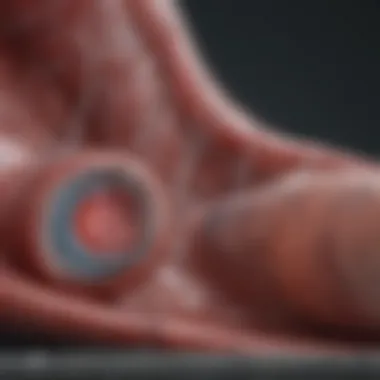Angioplasty vs Bypass: Key Differences Explained


Intro
The realm of cardiovascular interventions offers various strategies to address coronary artery disease, a condition that significantly affects millions worldwide. Among the most common treatment options are angioplasty and bypass surgery. Understanding the mechanisms, benefits, and drawbacks of each is crucial for patients and healthcare professionals alike. This comprehensive overview aims to clarify these two procedures, enabling informed choices in patient care.
The discussion will commence with a look into the methodologies associated with these treatments, followed by a thorough comparison of their respective advantages and disadvantages, and concluding with insights into post-operative care. Recent studies and expert opinions will enhance our understanding of these options, and their implications for both patients and healthcare providers.
Intro
The prevalence of coronary artery disease makes the exploration of treatment options vital for understanding how to effectively manage this condition. Angioplasty and bypass surgery are two prominent procedures that address the narrowing or blockage of the coronary arteries, but they do so through different methodologies and implications. This article seeks to dissect the nuances between these approaches, offering a detailed comparison to aid in decision-making.
Understanding the differences between angioplasty and bypass surgery is essential not only for patients but also for healthcare providers who must guide individuals through the complexities of their options. Both methods aim to restore adequate blood flow to the heart, yet the choice between a catheter-based technique and an open surgical procedure carries significant implications for recovery, success rates, and overall patient outcomes.
"The decision between angioplasty and bypass surgery is not merely a matter of preference; it requires careful consideration of multiple factors, including the patient's specific health profile and the severity of the disease."
The article explores key points, including the definitions, purposes, methodologies, and the risks typically associated with each procedure. By highlighting these elements, readers can gain a clearer understanding of both options, enabling more informed discussions during healthcare consultations. Moreover, this discourse invites health professionals to consider evolving treatments and recent research that could influence future decisions in managing coronary artery disease.
Overview of Coronary Artery Disease
Coronary artery disease (CAD) is a critical health issue, impacting millions globally. Understanding CAD is essential as it sets the stage for both angioplasty and bypass surgery, the primary interventions for treating this condition. CAD occurs when the coronary arteries become narrowed or blocked, often due to atherosclerosis, leading to reduced blood flow to the heart muscle. This reduction can cause chest pain, heart attacks, or even sudden cardiac death.
CAD is not merely a medical concern; it affects the quality of life and longevity for many individuals. The importance of recognizing and addressing CAD lies in its various implications for both patients and healthcare providers. Timely intervention can prevent adverse outcomes and improve survival rates. Furthermore, public awareness about CAD can promote lifestyle changes that minimize risk factors such as obesity, hypertension, and smoking.
Understanding CAD helps in easing the transition to exploring treatment options. Awareness of symptoms such as shortness of breath or chest discomfort can prompt early consultation with healthcare professionals. In a broader scope, identifying coronary artery disease guides individuals to seek effective treatments and preventive measures, ultimately benefiting society as a whole.
Definition and Importance
Coronary artery disease involves the narrowing or blockage of the coronary arteries due to plaque buildup. This buildup consists of cholesterol, fatty substances, and cellular waste, forming a thickened area in the artery wall called a plaque. The significance of this disease lies in its potential to lead to severe cardiovascular events, including heart attack or stroke. By recognizing the definition of CAD, one can appreciate the urgency to address this condition before it escalates.
Epidemiology and Risk Factors
The epidemiology of coronary artery disease reveals that it is a leading cause of death worldwide. Several risk factors contribute to the development of CAD, which are crucial to understand. Some of these include:
- Age: Older individuals have a higher risk.
- Family History: A genetic predisposition can play a role.
- High Blood Pressure: Hypertension can damage arteries over time.
- High Cholesterol: Elevated levels can lead to plaque formation.
- Diabetes: Increases the risk significantly.
- Obesity: Excess weight contributes to other risk factors.
- Smoking: Decreases oxygen in the blood and damages blood vessels.
- Physical Inactivity: A sedentary lifestyle raises the risk.
- Unhealthy Diet: Diets high in saturated fats and sugars can lead to CAD.
Recognizing these factors not only aids in diagnosing CAD but also in devising preventive strategies. As such, patient education along with risk factor management is crucial in reducing the incidence of coronary artery disease.
Understanding Angioplasty
Angioplasty is a crucial procedure in the management of coronary artery disease. It has gained prominence due to its effectiveness in alleviating blockages in the coronary arteries. Understanding this procedure is essential for patients and healthcare providers alike, as it offers insights into its application, benefits, and risks. This section delves into angioplasty, highlighting its significance in treating heart conditions, making it an indispensable part of this article.
Definition and Purpose
Angioplasty refers to a minimally invasive procedure designed to open narrowed or blocked coronary arteries. The primary purpose of this intervention is to restore blood flow to the heart muscle, which may suffer from reduced oxygen supply due to blockages. This procedure is vital for patients experiencing angina or those who have had a heart attack. By alleviating these symptoms, angioplasty can significantly enhance the quality of life and reduce the risk of future cardiac events.
Procedure and Techniques
The angioplasty process typically involves the use of a catheter, which is guided through the blood vessels to the site of blockage. Two prominent techniques used in angioplasty are balloon angioplasty and stenting procedures.
Balloon Angioplasty
Balloon angioplasty is the cornerstone technique of this procedure. It involves inflating a small balloon within the blocked artery to widen it. The key characteristic of balloon angioplasty is its ability to provide immediate relief by compressing plaque against the arterial wall. This technique is a beneficial choice because it is minimally invasive and can often be performed on an outpatient basis.


A unique feature of balloon angioplasty is its capability to be performed quickly, with a shorter recovery time compared to open-heart surgery. However, one disadvantage is that the artery may become narrowed again over time, a condition known as restenosis. This necessitates follow-up care to monitor the patient’s condition and may occasionally require further interventions.
Stenting Procedures
Stenting procedures often accompany balloon angioplasty. After the artery is widened, a small mesh tube, called a stent, is placed within the artery to keep it open. The key characteristic of stenting is that it provides structural support to maintain arterial patency. This makes it a popular choice in current medical practice.
A unique feature of stents is their variety, including drug-eluting stents which release medication to help prevent restenosis. The advantages of stenting include long-term support for the artery and a lower risk of recurrence of blockages. However, possible disadvantages include complications such as stent thrombosis, which can occur if a blood clot forms at the stent site.
Indications for Use
Angioplasty is indicated in several scenarios where coronary arteries are obstructed. Typical cases include:
- Patients with severe symptoms of angina that impair daily activities.
- Individuals who have experienced a myocardial infarction.
- Patients with significant narrowing in heart arteries that cannot be treated effectively with medication.
Benefits of Angioplasty
Angioplasty brings numerous benefits that enhance patient outcomes. Some notable advantages include:
- Reduction in chest pain and other symptoms associated with coronary artery disease.
- Minimally invasive, leading to faster recovery compared to surgical options.
- Generally shorter hospital stays, allowing patients to return to their normal lives quickly.
Risks and Complications
Though angioplasty is generally safe, it is not without risks. Potential complications may include:
- Bleeding or bruising at the catheter insertion site.
- Allergic reactions to the contrast dye used during the procedure.
- Risk of artery damage or restenosis, requiring additional procedures.
In summary, angioplasty plays a vital role in treating coronary artery disease. By understanding its definition, techniques, indications, benefits, and risks, patients are better equipped to make informed decisions about their heart health. This knowledge underscores the importance of angioplasty within the broader context of cardiovascular interventions.
Understanding Bypass Surgery
Bypass surgery is a critical procedure in the management of coronary artery disease. This intervention aims to restore adequate blood flow to the heart muscle, especially when arteries are blocked. Understanding the ins and outs of bypass surgery is essential for making informed decisions regarding treatment.
The discussion of bypass surgery often revolves around its effectiveness, indications, and potential risks. Grasping these specific elements allows patients and healthcare professionals to weigh the choice of surgery versus other interventions like angioplasty.
Definition and Purpose
Bypass surgery, or coronary artery bypass grafting (CABG), refers to a surgical procedure that reroutes blood around clogged arteries to improve blood flow to heart tissue. The primary purpose is to alleviate symptoms of coronary artery disease, such as chest pain or shortness of breath, and enhance quality of life. Moreover, it can also be a life-saving option, especially for patients with severe blockages that may lead to heart attacks.
Procedure Overview
The bypass surgery procedure is complex and requires careful planning and execution. Surgeons usually create a bypass using blood vessels taken from other parts of the body.
Types of Bypass Surgery
Bypass surgery can be categorized primarily into two types: traditional CABG and off-pump CABG. Traditional CABG involves stopping the heart and using a heart-lung machine. This allows the surgeon to operate on a still heart and provides a clear view of the coronary arteries. Off-pump CABG, on the other hand, is performed on a beating heart.
The unique feature of traditional CABG is its ability to provide excellent visibility and access to the heart. However, this method carries risks associated with the use of the heart-lung machine, including potential complications related to blood flow and oxygenation. Off-pump CABG is less invasive and may lead to quicker recovery, although the surgical field may be harder to navigate.
Techniques Used
Various techniques are employed during bypass surgery. The most common involves using grafts, which may come from the patient's saphenous vein, internal mammary artery, or radial artery. Each technique has distinct advantages. For instance, internal mammary artery grafts tend to have better long-term patency rates compared to saphenous vein grafts. The selection of technique can significantly impact recovery and overall outcomes.
Indications for Use
Bypass surgery is typically recommended for patients with significant coronary artery disease characterized by multiple blockages or left main coronary artery disease. Those who suffer from severe chest pain, even at rest, may also be candidates. It is crucial to assess the severity of blockages through diagnostic tests such as angiograms.


Benefits of Bypass Surgery
The primary benefits of bypass surgery include the restoration of proper blood flow, alleviation of symptoms, and often greater longevity. It may also significantly enhance the patient's quality of life by allowing for greater physical activity without the burden of chest pain.
In cases where angioplasty is not sufficient due to complex disease, bypass surgery stands out as a more comprehensive solution.
Risks and Complications
While bypass surgery has many benefits, it is not without risks. Common complications may include infection, bleeding, heart rhythm problems, and complications related to anesthesia. Long-term concerns can include graft narrowing or blockage. Therefore, patients must engage in thorough consultations with their healthcare provider to understand both the immediate and long-term risks associated with the procedure.
Overall, understanding bypass surgery is fundamental for anyone considering treatment for coronary artery disease. It offers an insight into a major intervention that can drastically improve heart health.
Comparative Analysis of Angioplasty and Bypass Surgery
The comparative analysis between angioplasty and bypass surgery is crucial in understanding the appropriate treatment options for patients suffering from coronary artery disease. These two procedures are the most common interventions used to restore blood flow to the heart. Each option has its unique methodologies, benefits, and limitations. A thorough examination of these variables assists in guiding patient decisions and facilitates effective communication between patients and healthcare providers.
Efficacy
The efficacy of both angioplasty and bypass surgery is a focal point in their comparison. Angioplasty typically aims for immediate relief by opening narrowed arteries, often resulting in quick symptomatic improvement. Studies show that over 90% of angioplasty procedures improve blood flow in the treated area. However, the durability of these results can be variable, with a percentage of patients experiencing restenosis. Bypass surgery, on the other hand, re-routes blood around the blocked arteries using grafts. This can lead to better long-term outcomes, particularly in patients with multiple blockages. Research highlights that, after 5 years, a significant proportion of bypass patients experience sustained symptom relief and lower rates of restenosis compared to their angioplasty counterparts.
Recovery and Rehabilitation
Recovery processes differ significantly between the two procedures. After angioplasty, patients often spend 1 to 2 days in the hospital, with a rapid return to daily activities, typically within a week. The minimal invasiveness allows for a quicker overall recovery, but patients may require ongoing monitoring for possible complications. In contrast, bypass surgery generally necessitates a longer hospital stay, ranging from 4 to 7 days, and a more extended total recovery period. Full rehabilitation can take several weeks to months due to the invasiveness of the procedure. Patients might benefit from structured cardiac rehabilitation programs post-surgery. These programs help strengthen the heart and educate on lifestyle modifications.
Long-term Outcomes
Long-term outcomes serve as a significant consideration for patients contemplating these procedures. Bypass surgery often provides a more durable solution for patients with severe coronary artery disease as it addresses blockages comprehensively. Research indicates that patients who undergo bypass surgery often enjoy better overall survival rates compared to those who have angioplasty for similar conditions. However, advancements in technology and stenting techniques in angioplasty are improving long-term success rates. As a growing body of evidence demonstrates, careful selection of patients for either procedure can optimize outcomes based on individual circumstances.
Cost Considerations
Cost analysis of both angioplasty and bypass surgery reveals substantial differences. Angioplasty is generally less expensive up front, with lower hospital and procedural costs. However, the potential need for repeat procedures due to restensosis can incur additional expenses over time. Bypass surgery has higher initial costs, partly due to its invasive nature and the longer hospital stay required. Yet, when considering long-term outcomes and the potential need for further treatments, the overall costs may even out. Patients should evaluate not only the immediate financial impact but also the long-term health care costs and quality of life implications after each procedure.
"Understanding the differences in efficacy, recovery, outcomes, and costs can empower patients in decision making about their heart health."
The comparative analysis of angioplasty and bypass surgery sheds light on the complexities of cardiovascular intervention. It remains essential for patients to engage in discussions with healthcare providers, ensuring their individual needs and conditions are addressed in the decision-making process.
Recent Advances in Treatment Options
Recent advances in treatment options for coronary artery disease have significantly improved patient outcomes and expanded the possibilities for intervention. Understanding these developments is crucial as they shape clinical practice and inform patient decision-making. Innovations in both angioplasty and bypass surgery techniques aim to enhance the efficacy, safety, and recovery experiences of patients.
Technological Innovations in Angioplasty
Angioplasty has seen remarkable technological advancements in recent years. These innovations improve the precision and effectiveness of the procedure. One notable advancement is the evolution of drug-eluting stents. Unlike bare-metal stents, these stents release medication that helps to prevent scar tissue from forming in the treated artery. This significantly reduces the rate of restenosis, which is a common issue with traditional stents.
Other innovations include enhanced imaging techniques. For instance, optical coherence tomography (OCT) provides high-resolution images of blood vessels, allowing for better assessment during the procedure. This helps in accurate placements of stents, minimizing complications. Additionally, the development of distal protection devices reduces the risk of debris traveling to smaller arteries during angioplasty. Just as importantly, advancements in balloon technology, such as cutting balloons and scoring balloons, offer more effective treatments for different types of arterial blockages.
Enhancements in Bypass Surgery Techniques
Bypass surgery has also benefited from newer techniques and materials. One major advance is the use of minimally invasive surgical approaches. These techniques often involve smaller incisions and less invasive methods for harvesting veins or arteries to use in bypassing blockages. This minimizes recovery time and reduces postoperative pain for patients.
Additionally, researchers are exploring the use of robotic-assisted surgery in bypass procedures. This technology can enhance precision and control during surgeries. Robotic assistance allows for better visualization and maneuverability, which is crucial in complex cases.
Furthermore, the development of bioengineered grafts represents a significant leap forward. These grafts can integrate with the patient’s anatomy better than traditional grafts. They are engineered to reduce the risks of rejection and complications, promising longevity and better perfusion.


In summary, advancements in treatment options not only enhance procedural outcomes but also aim to decrease recovery times and improve quality of life for patients.
The continuous evolution of techniques and technologies in both angioplasty and bypass surgery illustrates a commitment to improving patient care. As researchers and practitioners explore new avenues, they contribute to a better understanding and treatment of coronary artery disease.
Patient Perspectives and Decision-Making
Patient perspectives and decision-making are crucial elements in the context of angioplasty and bypass surgery. Understanding these factors can significantly impact outcomes and patient satisfaction. Individuals facing treatment for coronary artery disease often grapple with anxiety and uncertainty. They seek clarity on their options, as well as insights into how those options affect their overall health and quality of life.
Factors Influencing Choice of Procedure
Several factors affect the choice between angioplasty and bypass surgery. Each patient's medical history, the severity of their condition, and personal preferences play a role. Key considerations include:
- Severity of Blockages: If the coronary arteries have multiple significant blockages, bypass surgery may be more effective. In contrast, angioplasty might be suitable for isolated blocks.
- Patient Age: Older patients with comorbidities may favor less invasive procedures to minimize recovery time.
- Lifestyle and Preferences: Some patients may prioritize quicker recovery, finding angioplasty appealing because it often requires a shorter hospital stay.
- Long-term Goals: Patients might have different philosophies regarding their health care, which influences their decision. Some may look for long-term solutions, directing them towards bypass surgery, while others may want to avoid major surgery at all costs.
Considering these factors can help patients feel more empowered in their decision-making process. Moreover, discussions with healthcare providers often highlight these elements, providing a clearer picture.
Role of Healthcare Providers in Guidance
Healthcare providers play an essential role in guiding patients through their treatment options. They not only present choices but also offer crucial insights based on clinical expertise and patient history. A few ways healthcare providers facilitate the decision-making process include:
- Education: Providers explain the procedures, highlighting the risks and benefits associated with each. This educational aspect demystifies the surgical options.
- Personalized Recommendations: By evaluating individual health conditions, providers can recommend the most appropriate procedure tailored to the patient's needs.
- Emotional Support: Discussing complicated medical options can be intimidating. Providers who take the time to listen and address concerns create an environment of trust.
"Effective communication between patients and healthcare providers can significantly optimize outcomes and satisfaction"
The dialogue around treatment options is essential, as it contributes to patient confidence and adherence to treatment plans. Thus, understanding patient perspectives and the role of healthcare providers in decision-making is integral to achieving optimal health outcomes.
Finale
The conclusion serves as a critical component of this article, succinctly tying together the complex array of information regarding angioplasty and bypass surgery. Both procedures play significant roles in treating coronary artery disease, yet each presents unique implications, benefits, and risks that warrant careful consideration.
Understanding the distinctions between angioplasty and bypass surgery is essential for informed decision-making. Each procedure caters to differing anatomical conditions and patient needs. Angioplasty, with its less invasive nature, offers quick recovery times and reduced hospital stays. Conversely, bypass surgery, while more invasive, can address more severe blockages and provide long-term solutions for patients with extensive coronary artery disease.
When approaching the conclusion, it is important to highlight several key aspects:
- Patient-Centric Approach: The choice between angioplasty and bypass surgery should be driven by individual patient conditions. Factors include the severity and location of blockages, overall health, and personal preferences.
- Informed Choices: These procedures are not interchangeable. Each has its own set of indications, and understanding these can enable better healthcare outcomes. Patients must discuss thoroughly with healthcare providers to ascertain the best course of action.
- Continued Research: As advancements in medical technology evolve, new evidence can shift the paradigm regarding best practices for managing coronary artery disease. Staying abreast of the latest studies is vital for both patients and practitioners.
- Post-operative Care: The recovery process varies between the two procedures, influencing patient quality of life. Following the recommended rehabilitation programs can enhance recovery outcomes regardless of the procedure chosen.
In summary, this article provides a foundational understanding of angioplasty and bypass surgery, reflecting on their implications in the realm of cardiovascular health. The information presented here ultimately underscores the necessity for personalized treatment plans tailored to individual patient needs.
References and Further Reading
The section on References and Further Reading plays a crucial role in enhancing the overall value of this article. It serves as a gateway for students, researchers, educators, and healthcare professionals seeking to dive deeper into specific aspects of angioplasty and bypass surgery. By providing a well-curated list of sources, readers can explore related studies, data, and opinions that reinforce the content presented.
Importance of References
Accurate references are vital for multiple reasons:
- Credibility: Citing reputable sources increases the trustworthiness of the article. When readers see references to established medical journals or authoritative websites, they are more likely to accept the information provided as reliable.
- Further Exploration: Many individuals may have a general understanding of coronary artery disease and its treatments but seek more detailed knowledge. References offer avenues for more extensive reading, thereby catering to varied levels of expertise.
- Context and Evidence: The references can provide context and evidence for the claims made in the article. Readers benefit from seeing the underlying research, statistics, or case studies that inform the content.
Suggested Sources
To enrich the readers’ understanding, here are recommended sources:
- Wikipedia for foundational information on angioplasty.
- Britannica for clear definitions and summaries of coronary artery disease.
- Discussions on Reddit for community insights and personal experiences related to heart procedures.
- Relevant pages on Facebook for connecting with support groups and health organizations that focus on heart health.
By accessing these resources, readers can enhance their knowledge and make informed decisions regarding cardiovascular care.
Culmination
In summary, the References and Further Reading section is not only informative, but it also strengthens the article's integrity. By guiding the audience to explore further, it fosters a deeper understanding of the complex decisions surrounding angioplasty and bypass surgery. This well-rounded approach ensures that readers are well-equipped to engage in discussions or decision-making concerning their health or the health of others.



